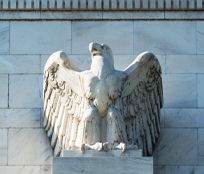In his speech today, which was delivered as part of the annual central bank symposium at Jackson Hole, Federal Reserve (Fed) Chair Jerome Powell focused on the economic outlook over the relatively near term. The broad strokes of Powell’s outlook are well understood: the labor market is moving from exceptionally tight to somewhat looser, albeit at a fairly slow pace. The inflation rate has moderated substantially over the last year and will likely continue declining over coming quarters. Monetary policy has moved to a restrictive stance and is expected to remain there for some time. Powell covered each of these topics pretty much as expected, delivering little by the way of surprises.
Notably Chair Powell’s speech did not emphasize the Fed’s analysis of long-run neutral rates (also commonly referred to as “r star”). In his only two comments on the subject, Chair Powell was circumspect: “we cannot identify with certainty the neutral rate of interest,” he said, and “we are navigating by the stars under cloudy skies.” While this topic has been featured recently in the financial media, it is not, apparently, a focus for Chair Powell right now. In fact, to get a fuller sense of what Chair Powell thinks on this topic, one has to go back five years to his speech at the same Jackson Hole symposium. In 2018 Chair Powell argued “the stars” are not a particularly useful guide for policymakers. Rather than set policy based on these theoretical concepts, he said, in many cases it may be preferable to “wait one more meeting” in order to gather more data. Chair Powell’s approach—pragmatic and incremental—stands in contrast to many recent commentaries, which have tended to be a bit breathless in tone while jumping to very strong conclusions about the long term.
How should we interpret Chair Powell’s downplaying of a concept that has been covered so prominently by the financial press? And what implications does Chair Powell’s speech have for fixed-income markets going forward?
First, Chair Powell seems appropriately aware of the elevated uncertainty surrounding the long-term outlook. As a consequence, he is likely on guard against the bias, well documented among economists, to over-extrapolate growth surprises today far into the future.1 Arguably, economists should work extra hard to suppress that bias in the current environment, which is characterized by so many extraordinary circumstances, most of which are both about to end and also unlikely to be repeated. To highlight just one example: this year, consumers have weathered the storm of higher costs and lower incomes by drawing down their stock of savings. While possible this year, due to the large build-up in savings during the pandemic years, this likely will not be possible next year and certainly won’t be possible over the long run.
Second, Chair Powell is likely aware that risk premia can be volatile, and often changes in risk premia are correlated with growth surprises. This complicates an interpretation of higher bond yields as indicative of a change in the long-run neutral rates. The past few months have been a pretty clear example of this tendency. In late March and early April many investors were concerned about regional bank stress, and the heightened recession risks that accompanied it. In that environment, bond yields declined along with the prices of risk assets. As growth proved resilient through the summer, however, investors became more optimistic, which corresponded with both higher bond yields and higher prices for risk assets. It’s not at all clear how much this had to do with estimates of long-run economic potential.
Third, Chair Powell is undoubtedly aware that expectations for long-term interest rates may depend on the near-term success of the Fed’s policies. The Fed’s eventual success in bringing down inflation may influence longer-term bond yields along two dimensions. The inflation expectations, and inflation risk premium, embedded in long-term bond yields will decline straightforwardly. Perhaps more consequentially, further declines in the inflation rate will eventually allow the Fed to return real interest rates to more normal levels. New York Fed President John Williams recently suggested that process could begin as early as next year, conditional on inflation moving back toward the Fed target. As that process gets underway, market participants will likely reduce their expectations for long-term real rates as well. But inflation needs to continue declining first. Hence Chair Powell’s focus, appropriately, on the near term, and his apparent reluctance to get drawn into a discussion of the long term.
In our view, all of these points suggest there may be considerable value in the bond market at current yields. The extraordinary nature of the post-pandemic environment cautions against over-extrapolating resilient growth too far into the future. Further, this year bonds have been negatively correlated with risk assets. Negative correlations are useful in constructing diversified portfolios, and can be particularly useful during periods of optimism and highly valued risk assets. (The negative correlation seen this year is particularly notable, as its absence last year caused diversified portfolios to exhibit greater than anticipated volatility.) Finally, long-term interest rates are currently elevated both relative to recent history as well as relative to most estimates of normal. This is particularly true for long-term real rates, which have borne the brunt of the most recent repricing. Further declines in inflation in the near term—which remains Chair Powell’s focus, as evident in his speech today—will likely correspond with a decline in those long-term rates.
ENDNOTES
1. ''Learning about the long run,'' L. Farmer, E. Nakamura and J. Steinsson, UC Berkeley, Feb 2023.
https://eml.berkeley.edu/~jsteinsson/papers/learning.pdf



